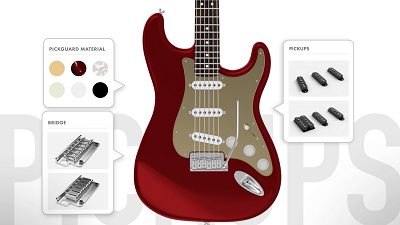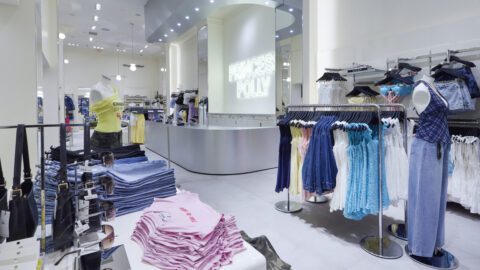Unless you happen to be a guitar-smashing heavy metal rock star, it’s unlikely you’ll be buying multiple guitars from 70-year-old instrument maker Fender. So the company has a strong incentive to ensure that customers love the purchases they make, and also that they get exactly the guitar that they want — down to the tiniest detail.
This is a particular challenge in serving the shoppers who choose to customize their Fender guitars. With options ranging from the materials used to make various parts of the instrument to color choices for the body, fingerboard and pickguard, the number of possible combinations quickly mushrooms. (For the iconic Fender Stratocaster alone there are more than 50,000.)
Streamlining And Visualizing The Customization Process
To help guide shoppers through the design process, Fender introduced its Mod Shop on June 14, 2016. “We wanted to do something the apparel guys do, which is narrow down the choices based on the data,” said Ethan Kaplan, Chief Product Officer and General Manager of Fender Digital. Customizing a guitar is a “very bespoke experience, but no one will be able to make a decision when there are something like two million possibilities.”
Advertisement
Fender partnered with e-Commerce software developer Fluid to create a visually rich customization program, complete with realistic 3D views that can rotate 360 degrees to show the customer’s choices being added to the guitar in real time. The Fluid Configure solution provides “build your own” capabilities for a number of brands including Oakley sunglasses, Reebok, The North Face, Brooks Brothers and Timberland.
The Fluid technology allows Fender to:
• Deliver the same customizing experience via desktop, mobile and the sites of Fender’s retail partners;
• Automatically update choices that affect elements of the instrument’s design, so that the finished product is always capable of being manufactured and producing music;
• Feed finished “recipes” into the Fender production line via APIs, and show the Fender craftsmen the same images that customers have been working from; and
• Simplify customers’ ability to share images of their personalized instruments through an online gallery, email or social media.
[This video tutorial shows how the process works.]
When a customized guitar choice is shared in these ways, other customers “can click on the message to open up the ‘configurator’ for all the choices that the person has made,” explained Neil Patil, Software Group President at Fluid. “They can access a community of consumers that love the brand and are expressing their own creations, and members of this community can buy another person’s design, or tweak it for themselves.
“These people are expressing their style with the guitar they choose, which is particularly important with musicians,” Patil added in an interview with Retail TouchPoints. Simplifying the ability to share images of customized guitars also gives these purchasers “the opportunity to market the Fender guitar through their own Facebook pages or networks like Pinterest.”
Avoiding The “Frankenstein” Guitar
Fender’s personalization efforts are critical to its mission and long-term customer satisfaction. “We make a product where every aspect of the form is part of the function,” said Kaplan in an interview with Retail TouchPoints. “The more personal an instrument is, the more likely it is that people will return to it. We want people to be musicians, and we want to engage them.”
While Fender wants its customers to express their creativity through their choices, they also want to ensure that the finished guitar will be both playable and aesthetically pleasing. Fender understands that buying a customized guitar is an investment of both money and time: The base models of these guitars range in price from $1,649.99 to $1,799.99 depending on modifications, and they can take as long as 30 days to be made to order.
The Fluid solution helps guide shoppers toward creating an instrument that will work for them. “We can suggest certain color and model combinations for people to start from,” said Kaplan. “They can then move to different pickup, neck and hardware options. This makes for greater fluidity in the process, versus someone ‘Frankensteining’ a guitar together.”
Ultimately, however, the Fender Mod Shop is designed to let shoppers’ creativity out to play. “It’s super-personal to these customers that they had a hand in designing their guitar,” said Kaplan. “It’s also a modern take on what has been the 70-year fabric of our company’s existence. Mod Shop allows us to create new products by the tens of thousands that don’t exist anywhere else on the planet, but at their core they are still an American-made Fender product, so it continues the legacy in that way.”















